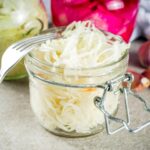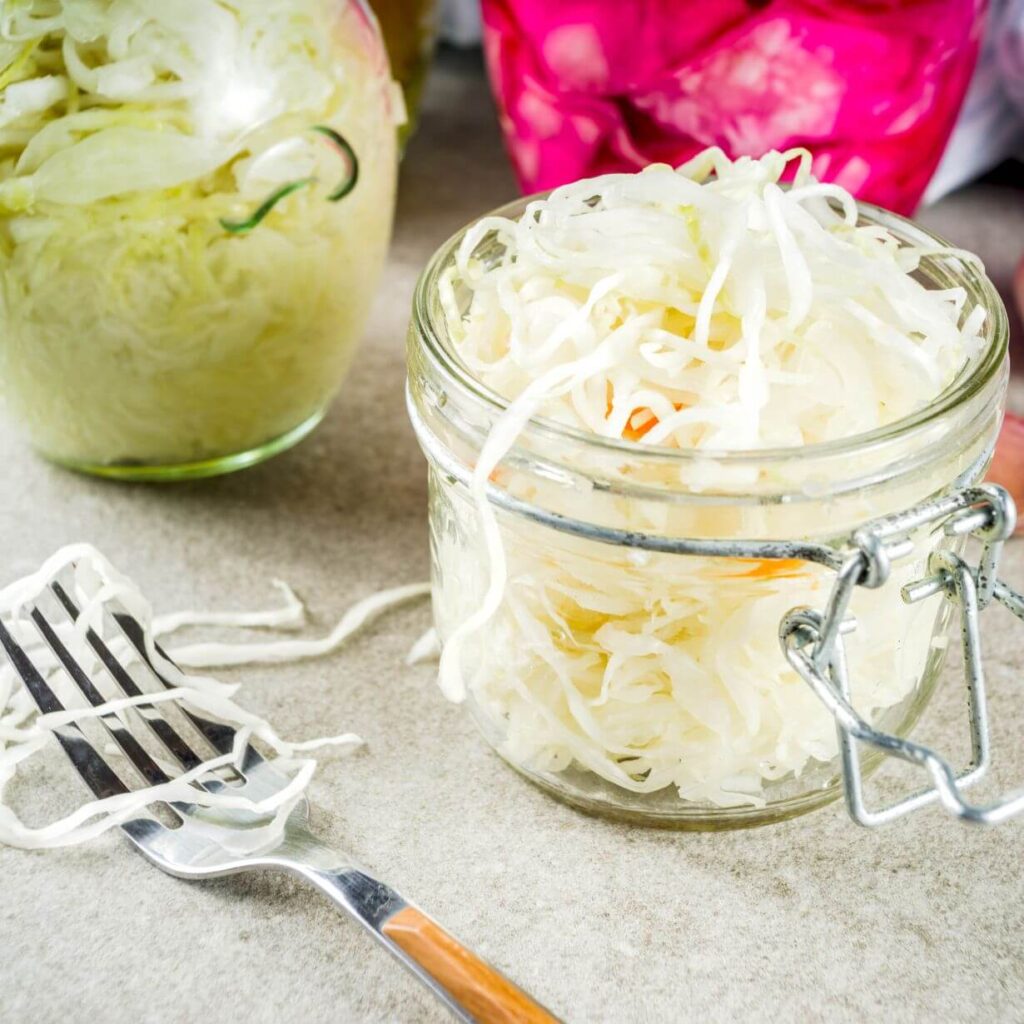
A jar of gut lovin’ dill pickle sauerkraut is the ultimate flavour-boosting tool. Its distinctive sour flavour is perfect for adding an extra something to salads, abundance bowls, scrambled eggs, pulled pork and even soup!

Just imagine taking a bite of savoury pulled pork, with a refreshing, tart, and crisp flavour. That sharp contrast is seriously irresistible, and why I love fermented foods – especially sauerkraut. And bonus, sauerkraut is ridiculously easy to make!
Sauerkraut ingredients
All you need for a basic sauerkraut is just finely cut raw cabbage and sea salt, that’s it! But you can enliven it with different flavours. In this recipe I’ve added cucumber, dill, garlic, black peppercorns, and caraway seeds.
- Cabbage: I’m using white cabbage, which is used in most traditional sauerkraut recipes. But you can also use red cabbage or even Savoy.
- Sea salt: Salt helps pull water from the cabbage to make the brine for the cabbage to be fermented in. The brine is very important for creating an environment that supports the growth of lactobacillus bacteria. Lacto-fermentation is anaerobic (without air), so you need to have the cabbage under the brine for it to happen. Otherwise you will end up with mouldy cabbage instead.
- Cucumber: A thinly sliced cucumber adds a mild, sweet flavour.
- Dill: Adds a fresh, citrus taste.
- Garlic: Rounds out the other flavours.
- Black peppercorns: To infuse the kraut with a spicy flavour.
- Caraway seeds: infusing with caraway seeds adds a mild anise (liquorice) flavour. Caraway also supports digestion and helps to relieve gas, bloating and indigestion.
Below I’ve noted down a few other ways you can add different flavours to this recipe.
How to make sauerkraut
I like to use a Kilner clip top 1 litre glass jar for kraut, but any medium-sized glass jar will work.
- Shred the cabbage. You can use either a knife, mandoline or grater to shred the cabbage. This will make it easier for the onions to absorb the vinegar. Then place the cabbage into a large bowl.
- Make the brine. Sprinkle the cabbage with salt and set aside for 5 minutes. Use a muddler or the end of a rolling pin to massage the cabbage until the juices start to escape.
- Boost the flavour. Add the cucumber, dill, garlic, black peppercorns and caraway seeds and use your hands to mix until well combined. Transfer to the kilner jar, pushing down firmly so that the cabbage is tightly packed with no gaps and the juices cover the top of the cabbage by 2cm (¾ inch). Top up with filtered water if needed, but leave at least 2cm (¾ inch) at the top of the jar for expansion.
- Let the fermenting begin! Cover the jar with a clean tea towel or muslin cloth and secure with an elastic band. Place in a cool, dark place to start the fermentation process. Leave for 3–5 days, checking the fermentation every day to make sure the juices still completely cover the cabbage. Push the cabbage down and top up with filtered water if needed.
- Ready to eat. The sauerkraut is ready when bubbles start to appear on the surface. If you like a stronger flavour, you can leave the kraut at room temperature for another 2–3 days. Once you’re happy with the flavour, remove the tea towel or muslin cloth, seal the jar with a lid and store in the fridge. The sauerkraut will keep for up to one month in the fridge.
Give your sauerkraut a flavour boost
This dill pickle sauerkraut tastes insanely good as is. But if you want to switch things up a bit – here’s a few ways to add some fun flavours and give your kraut a little boost!
- Stir in beetroot. Peeled and grated or thinly sliced, even a tiny bit of beet stains the whole ferment fuchsia. Or golden, if you use a yellow beet. Sweet earthy flavour complements the acidic tang of kraut. Because they contain so much sugar, they can skew a ferment that is not salty enough if used in too large a proportion. A good rule of thumb is to use at least 75% cabbage and the rest can be other ingredients, like beet.
- Lemon peel. The peel of a single unwaxed lemon, cut into thin strips, blended with garlic and dill in a green cabbage kraut – bliss. Notable for it’s texture, dense and firm and much unlike the crunch of cabbage.
- Add a punch of ginger. There’s a special magic to ginger, the way it warms and spices anything it touches. Ginger and beet is an especially unique combination that I love in kraut.
- Carrot. Slice it thinly into coins, or grate it into shreds. Pair it with lemon and ginger, or with radish
- Add juniper berries. Small and dark, these little raisin-sized berries pack a flavour punch. A classic kraut addition, and visually pleasing, too – the purple-black berries studded among the green kraut.
- Celeriac. Peel it and grate it into a kraut, along with apple and fennel for an unusual and delicious combination.
Ways to use sauerkraut
There’s no right or wrong answer when it comes to using sauerkraut. Just use it whenever you want to add a bit of tang to your meals! But here’s a few ways you can never go wrong with:
- Add to your favourite bowls. No matter what kind of bowl you have, whether it be a spicy burrito bowl or rainbow abundance bowl, sauerkraut is always welcome.
- Layer onto salads. Sauerkraut is great with salads such as strawberry spinach salad, broccoli, spinach and feta salad, or layered into a jar salad.
- Top on your favourite proteins. Whether it’s pulled pork, easy baked salmon ratatouille, or spiced salmon traybake, this sauerkraut will add a deliciously sharp freshness.
- Serve with eggs. I love a side of kraut with eggs of any kind, think traditional shaksuka, spring vegetable shakshuka, breakfast egg muffins, courgette fritters, or simply alongside soft-boiled eggs.
- Top them on soup. Think broccoli soup, creamy celery soup, or pea soup.
I hope you enjoy this sauerkraut recipe. If you make it, let me know how it turned out. I’d love to hear what you think in the comments below, or post in The Fertility Kitchen Community.
Dill pickle sauerkraut
Ingredients
- 1 kg white cabbage finely shredded
- 1 tbsp sea salt flakes
- 2 tbsp fresh dill roughly chopped
- 1 cucumber thinly sliced
- 5 garlic cloves crushed
- 2 tsp fennel seeds
- 1 tsp black peppercorns
Instructions
- Place the cabbage in a large bowl, sprinkle with the salt and set aside for 5 minutes. Use a muddler or the end of a rolling pin to massage the cabbage until the juices start to escape.
- Add the dill, cucumber, garlic, fennel and black peppercorns and use your hands to mix until well combined.
- Transfer to a sterilised 1 litre glass jar, pushing down firmly so that the cabbage is tightly packed with no gaps and the juices cover the top of the cabbage by 2cm (¾ inch). Top up with filtered water if needed, but leave at least 2cm (¾ inch) at the top of the jar for expansion.
- Cover the jar with a clean tea towel or muslin cloth and secure with an elastic band. Place in a cool, dark place to start the fermentation process. Leave for 3–5 days, checking the fermentation every day to make sure the juices still completely cover the cabbage. Push the cabbage down and/or top up with filtered water if needed.
- The sauerkraut is ready when bubbles start to appear on the surface. If you like a stronger flavour, you can leave the kraut at room temperature for another 2–3 days. Once you are happy with the flavour, remove the tea towel or muslin cloth, seal the jar with a lid and store in the fridge.
Notes
- The sauerkraut will keep for up to one month in the fridge.
comments +